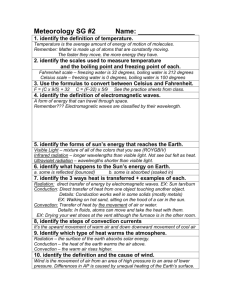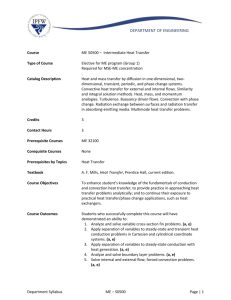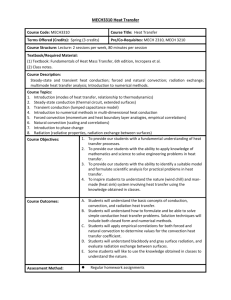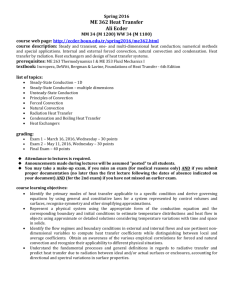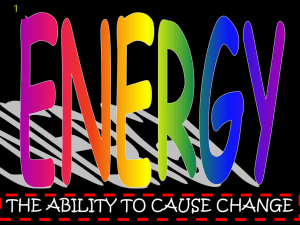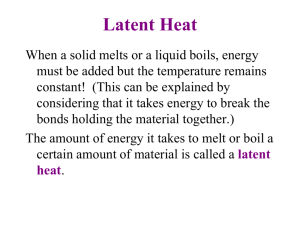MECH 343 Heat Transfer
advertisement
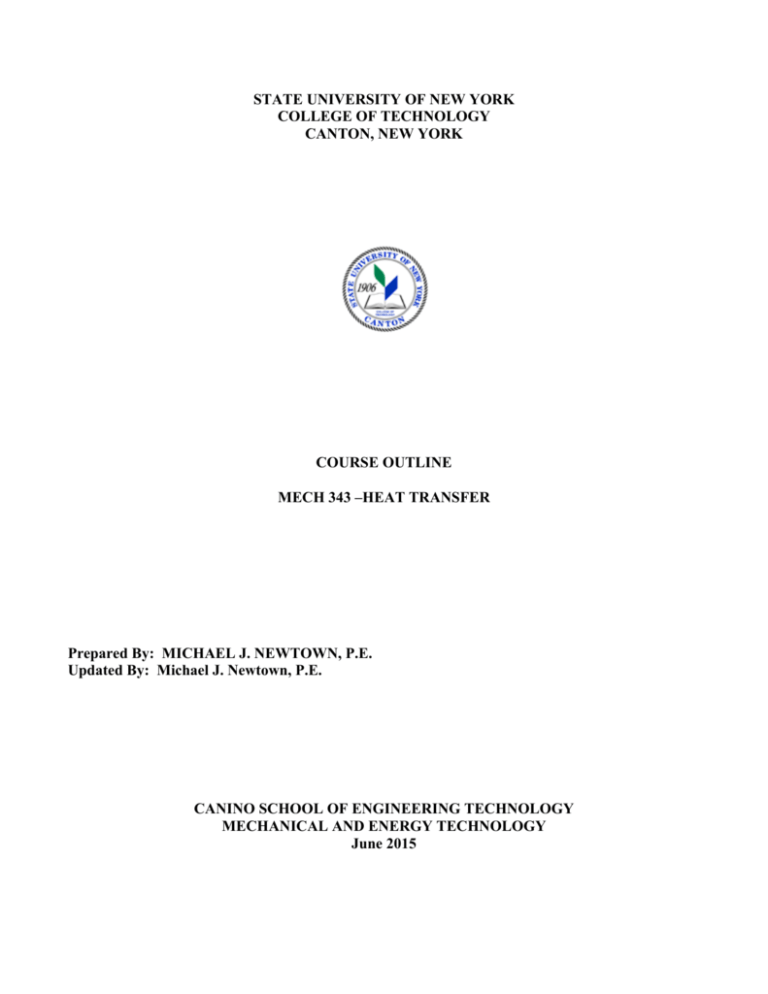
STATE UNIVERSITY OF NEW YORK COLLEGE OF TECHNOLOGY CANTON, NEW YORK COURSE OUTLINE MECH 343 –HEAT TRANSFER Prepared By: MICHAEL J. NEWTOWN, P.E. Updated By: Michael J. Newtown, P.E. CANINO SCHOOL OF ENGINEERING TECHNOLOGY MECHANICAL AND ENERGY TECHNOLOGY June 2015 A. TITLE: Heat Transfer B. COURSE NUMBER: MECH 343 SHORT TITLE: Heat Transfer C. CREDIT HOURS: 3 D. WRITING INTENSIVE COURSE: No E. LENGTH OF COURSE: 15 Weeks F. SEMESTER(S) OFFERED: Fall/Spring G. HOURS OF LECTURE: 3 hours/ week H. CATALOGUE DESCRIPTION: This course explores the various methods of transferring heat from a source to a sink in engineering systems. Topics will focus on the energy balance of a system. The transport phenomena of heat transfer will be studied in detail, allowing students to internalize these physical principles of conduction, convection, and radiation. I. PRE-REQUISITES: Differential Equations (MATH 364) J. STUDENT LEARNING OUTCOMES: Upon completion of the course, the student will be able to: Course Objective a. Define the transport methods of convection, conduction, and radiation. b. Calculate the energy flow in combined transfer of conduction, convection, and radiation. c. Calculate the coefficient of convection during laminar, turbulent, and separated flow. d. Evaluate radiation from a blackbody, gray surface, and diffuse surface. Institutional SLO 1. Communication 2. Critical Thinking 3. Professional Competence 2. Critical Thinking K. TEXTBOOK: Çengel, Y.A. & Ghajar, A.J., Heat and Mass Transfer: Fundamentals & Applications, 4th Edition, McGraw Hill, 2007 L. REFERENCES: Schaum’s Outlines, Heat Transfer, 2nd Edition, McGraw Hill, 1998 Chapman, Alan, J., Heat Transfer, 4th Edition, MacMillan, 1984 M. EQUIPMENT: Technology enhanced classroom N. GRADING METHOD: (P/F, A-F, etc.): A-F O. MEASUREMENT CRITERIA/METHODS: Exams, Quizzes, Homework P. DETAILED TOPICAL OUTLINE: See Attached Q. LABORATORY OUTLINE: Not Applicable DETAILED COURSE OUTLINE I. II. III. IV. V. VI. VII. Introduction A. Origins of conduction, convection, radiation B. Conservation of energy C. Methodology for problem solving D. Overview of heat transfer applications E. Units and dimensions Conduction A. Thermal properties of materials B. Boundary and initial conditions C. One-dimensional steady state conduction 1. Plane walls 2. Radial systems 3. Thermal energy generation 4. Transfer from extended surfaces (fins) D. Two-dimensional steady state conduction 1. Graphical method 2. Finite-Difference equation 3. Nodal networks Transient Conduction A. Lumped Capacitance B. Spatial effects C. Semi-infinite solids D. Multi-dimensional effects Convection A. Boundary Layers 1. Velocity dependant 2. Thermal dependant B. Laminar flow C. Turbulent flow D. Reynolds Analogy E. Dimensionless Parameters External flow A. Flat plate B. Cylinder in cross flow C. Banks of tubes in heat exchangers Internal flow A. Flow conditions B. Friction factors of developed flow C. Newton’s Law of Cooling D. Shell and tubes exchangers E. Cross and parallel flow heat exchangers Free Convection A. Laminar flow B. Turbulent flow VIII. IX. C. Vertical and inclined surfaces and channels D. Combined free and forced convection Boiling and Condensation A. Boiling of a pool B. Nucleate boiling C. Film boiling Radiation A. Emission B. Irradiation C. Radiosity D. Blackbody radiation E. Absorption, reflection and transmission F. Kirchhoff’s Law G. Gray surface H. Exchange between surfaces I. Radiation shielding
![Applied Heat Transfer [Opens in New Window]](http://s3.studylib.net/store/data/008526779_1-b12564ed87263f3384d65f395321d919-300x300.png)
